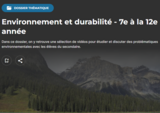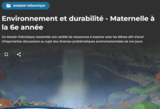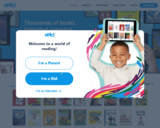
Project Proposal, Research, Content, Collaboration, Reflection
- Subject:
- Science
- Material Type:
- Activity/Lab
- Date Added:
- 10/01/2018

Project Proposal, Research, Content, Collaboration, Reflection

I created this rubric for the Student - Directed Study outcome in Environmental Science 20. I wanted to leave the rubric very broad - based in order to give the students freedom to choose how they wanted to complete the project. Fostering creativity in our students is one of the 21st CCs (Competency 1: Creativity, Innovation, Entrepreneurship). By giving our students freedom to choose what they want to learn, how they want to go about learning it, and how they want to demonstrate their learning, we are embodying 21st Century Assessment practices. This assessment also gives the student a chance to think critically (competency 2), as they must complete research and then use the research to conclude how to answer their research question. The ability to acquire and process and wide variety of information to find out what is relevant is a major part of critical thinking. In this project, the students are required to work with at two of their peers at different times throughout the project to peer assess and collaborate in order to improve their projects. The idea of working with your peers to improve your product is part of 21st CCs (number 3), and is an essential skill for the students to have as they enter the work force. Throughout this assignment, the students will use a variety of forms of technology in order to complete their research and present their findings, which falls under competency #7.

TED Studies, created in collaboration with Wiley, are curated video collections 壽� supplemented by rich educational materials 壽� for students, educators and self-guided learners. In Climate Change, speakers give talks that boldly illuminate the nature and scale of current-day climate science, policy and ethics. They explore the economics and psychology of individual and collective action 壽� or inaction 壽� on climate change in order to assess the costs of our choices and opportunities for change. Relevant areas of interest, study and coursework include: ecology, atmospheric science, oceanography, glaciology, energy development, environmental policy, science in the media, political science, ethics, sociology, behavioral psychology and cultural studies.

This unit plan overview provides links to all lessons along with links to accompanying teacher support materials that include: video links, student worksheets and answer guides for individual lessons, Inquiry activities with support materials for 5 lessons on climate change and how we can work towards slowing its progress. Also includes the inquiry lesson of developing a student's own action plan.

Students explore the biosphere and its associated environments and ecosystems in the context of creating a model ecosystem, learning along the way about the animals and resources. Students investigate different types of ecosystems, learn new vocabulary, and consider why a solid understanding of one's environment and the interdependence of an ecosystem can inform the choices we make and the way we engineer our communities. This lesson is part of a series of six lessons in which students use their growing understanding of various environments and the engineering design process, to design and create their own model biodome ecosystems.

Dans ce dossier, on y retrouve une sélection de vidéos pour étudier et discuter des problématiques environnementales avec les élèves du secondaire.

Ce dossier thématique rassemble une variété de ressources à explorer avec les élèves afin d’avoir d’importantes discussions au sujet des diverses problématiques environnementales de nos jours.

The forests of North America have seen plenty of change in a pretty short period of time, at least geologically speaking. Up until about 18,000 years ago, the Laurentide Ice Sheet covered Canada and much of the eastern United States. When temperatures climbed and the ice sheet retreated, forests gradually reemerged. But how? Did pockets of trees find refuge in sheltered areas during the Ice Age? Or were all tree species pushed to the southern tier of the United States, only to spread north again after the ice disappeared? Scientists still debate the topic, but one thing is clear: today‰Ûªs forests in the eastern United States bear little resemblance to post-glacial forests. Starting with European colonial settlers and marching through four centuries of development, drought, and fire, the tree cover of North America became fragmented.

Epic Books is an online collection of over 40 000 titles of award-winning fiction, non-fiction, STEM (Science, Technology, Engineering, and Mathematics), biographies, graphic novels, DIY (Do It Yourself) and more. Sign up as an educator and the account is free. Epic Books can be used by teachers and students for read-alouds, shared reading, and independent reading time. Read-to-me and audiobook functions allow for the listening portion of a balanced literacy program. Teachers can use these books as part of interactive small group instruction for specific skills or strategies. They can also assign certain books and tasks for practice to individuals or groups.
Free for teachers - you must set up the free account and add students to your classroom in order to get a class code to provide to families. Then when students have that code, they can log in from home with free access.

This lesson is designed to supplement a high school English class reading The Crucible or a high school history class studying the Salem Witch Trials. Students will understand one theory of the cause of the witch trials and how they could have been prevented.

Students learn about water erosion through an experimental process in which small-scale buildings are placed along a simulated riverbank to experience a range of flooding conditions. They learn how soil conditions are important to the stability or failure of civil engineering projects and how a river's turns and bends (curvature, sinuosity) make a difference in the likelihood of erosion. They make model buildings either with a 3D printer or with LEGO® pieces and then see how their designs and riverbank placements are impacted by slow (laminar) and fast (turbulent) water flow over the soil. Students make predictions, observations and conclusions about the stability of their model houses, and develop ideas for how to mitigate damage in civil engineering projects.

Human Anatomy and Physiology is designed for the two-semester anatomy and physiology course taken by life science and allied health students. The textbook follows the scope and sequence of most Human Anatomy and Physiology courses, and its coverage and organization were informed by hundreds of instructors who teach the course. Instructors can customize the book, adapting it to the approach that works best in their classroom. The artwork for this textbook is aimed focusing student learning through a powerful blend of traditional depictions and instructional innovations. Color is used sparingly, to emphasize the most important aspects of any given illustration. Significant use of micrographs from the University of Michigan complement the illustrations, and provide the students with a meaningful alternate depiction of each concept. Finally, enrichment elements provide relevance and deeper context for students, particularly in the areas of health, disease, and information relevant to their intended careers.

Students learn that buoyancy is responsible for making boats, hot air balloons and weather balloons float. They calculate whether or not a boat or balloon will float, and calculate the volume needed to make a balloon or boat of a certain mass float. Conduct the first day of the associated activity before conducting this lesson.

This math problem determines the areas of simple and complex planar figures using measurement of mass and proportional constructs. Materials are inexpensive or easily found (poster board, scissors, ruler, sharp pencil, right angle), but also requires use of an analytical balance (suggestions are provided for working with less precise weighing tools). This resource is from PUMAS - Practical Uses of Math and Science - a collection of brief examples created by scientists and engineers showing how math and science topics taught in K-12 classes have real world applications.

After Darwin blew the doors off the scientific community, a lot of people did some weird and unscientific stuff with his ideas. Francis Galton and a few others decided natural selection could be used to make the human race "better" and came up with Eugenics.

Hank tells us about the city of Eukaryopolis - the animal cell that is responsible for all the cool things that happen in our bodies.

Students explore material properties in hands-on and visually evident ways via the Archimedes' principle. First, they design and conduct an experiment to calculate densities of various materials and present their findings to the class. Using this information, they identify an unknown material based on its density. Then, groups explore buoyant forces. They measure displacement needed for various materials to float on water and construct the equation for buoyancy. Using this equation, they calculate the numerical solution for a boat hull using given design parameters.

As part of this activity, students learn about geologic processes on Earth in order to interpret surface features recently seen on Europa by NASA's Galileo spacecraft. Materials presented here include a vocabulary list, geology jigsaw puzzle, review questions, and links to related sites.

This is a hands-on lab activity about evaporation. Learners will conduct experiments to observe the process of evaporation. They will then describe the process of evaporation, and the general water cycle, through discussion and pictures. Background information, common preconceptions, a glossary and more is included. This activity is part of the Aquarius Hands-on Laboratory Activities.

Developed for second grade. The students will get an understanding on the stages of the water cycle and will be able to visually see how water evaporates while salt, a solid at room temperature, does not.Biology In Elementary Schools is a Saint Michael's College student project. The teaching ideas on this page have been found, refined, and developed by students in a college-level course on the teaching of biology at the elementary level. Unless otherwise noted, the lesson plans have been tried at least once by students from our partner schools. This wiki has been established to share ideas about teaching biology in elementary schools. The motivation behind the creation of this page is twofold: 1. to provide an outlet for the teaching ideas of a group of college educators participating in a workshop-style course; 2. to provide a space where anyone else interested in this topic can place their ideas.